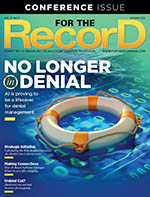Autumn  2025 Issue
2025 Issue
Coding Corner: The New Look of Coder Education
By Selena Chavis
For The Record
Vol. 37 No. 3 P. 6
It’s a great time to enter the field of health care coding. According to AAPC’s 2025 Medical Coding and Billing Salary Report, coding is expected to experience healthy growth in terms of demand and salary for the foreseeable future.
Notably, the US Bureau of Labor Statistics projects 9% average yearly growth in the health care business industry through 2033. That’s compared with a 4% average growth rate for all careers. And medical record specialists, including coders and billers, earned a median annual income of $65,401 in 2024—a competitive salary compared with the national average, especially given the low barriers to entry for the profession: coders can often be job-ready in less than a year.
Robin Tripp, MAS, RHIA, CCS-P, CPC, CRC, director of education, revenue cycle, and coding for AHIMA, says she is particularly excited about the flexibility and innovation shaping both education and the job of coding itself. “With online learning and virtual events, students can skill up and connect with peers from anywhere, even while working full time,” she says. “AI-powered study tools have made tasks like note taking and reading and interacting with textbooks much easier, allowing students to use their time more efficiently.”
Colleen Kolbeck, CPCO, CPMA, CPC, CPC-I, a custom trainer with AAPC, says that the expanding scope of the coding field will continue to have a significant impact on the profession. “Newcomers to the field are entering a space that’s no longer just about assigning codes: It’s about contributing to data accuracy, compliance, revenue integrity, and even quality outcomes,” she explains. “Coders today are strategic contributors to health care organizations. With access to more robust education and technology, new professionals are more empowered than ever to shape the future of the industry.”
As these factors contribute to the growing interest in coding, education models are also evolving to better address the future of the field. Following are three ways training models are advancing for the better:
1. No more cookie-cutter approaches.
Education for coders has shifted dramatically from traditional, one-size-fits-all instruction to more flexible, learner-centered models. According to Kolbeck, online platforms now offer asynchronous learning, interactive case-based scenarios and real-time coding labs, making it easier for adult learners to improve at their own pace.
“Many programs also incorporate microlearning and adaptive learning technologies, allowing educators to tailor content to a learner’s strengths and gaps,” she notes. “These innovations are producing coders who are not only technically proficient but also better equipped to apply critical thinking to documentation, compliance, and revenue cycle challenges from day one.”
Tripp agrees, but also emphasizes that while the broader adoption of competency-based education allows students to progress based on skill mastery rather than fixed academic schedules, they can limit opportunities to build community. “The rise of online and asynchronous learning has greatly expanded flexibility, especially for working adults. However, online formats can sometimes make it harder for students to build professional networks and form connections they might naturally find in traditional, in-person settings,” she points out. “Because networking is so essential—not only for career growth but also for continuing education and staying current with industry best practices—it’s crucial for students, new, and seasoned professionals to actively seek out opportunities to connect with peers and thought leaders.”
Tripp suggests events such as AHIMA’s Virtual Coding Summit and AI Summit, as well as actively engaging with professional associations through virtual and in-person events.
2. Technology is transforming coding education.
Emerging technology has enhanced coding education, offering more flexible learning through a mix of platforms, Tripp says. Alongside structured programs, content creators using social platforms like YouTube and TikTok now deliver quick, bite-sized learning.
Kolbeck points to multiple options for interactive, flexible, and accessible learning experiences including learning management systems, simulation software, and virtual classrooms. “Students can engage in real-time coding exercises, quizzes, and peer discussions that reinforce understanding,” she says. “Going forward, we’ll see a growing emphasis on emerging topics like data analytics, revenue integrity, interoperability, and digital health literacy, equipping coders to adapt to the broader digital transformation occurring across the health care industry.”
AI is enhancing not only what is taught but also how it is taught, Tripp adds, pointing to how platforms powered by AI are beginning to personalize education by adapting to individual skills and needs. “The role of AI in medical coding education is shifting from abstract theory to real-world application. Where the focus was once on understanding what AI is, we’re now emphasizing how coders can use AI tools efficiently in their daily workflows,” she says.
Kolbeck believes AI will continue to be a hot topic in coding education, emphasizing that while the industry should draw on these tools to improve processes, coders must be trained to understand the limitations of AI-generated suggestions. “Coding professionals need to be educated on how to validate AI recommendations, ensure clinical relevance, and identify documentation gaps that AI might miss,” she explains. “The future of coding education will emphasize collaboration between human expertise and AI, not replacement.”
3. Specialization is important for career growth.
As AI and automation increasingly handle more routine coding tasks, there’s a growing need for medical coders to specialize in areas where human judgment remains critical, Tripp says. “These include auditing AI-generated outputs, managing complex or ambiguous coding scenarios, and ensuring compliance with evolving regulatory standards,” she explains, noting that risk adjustment has emerged as a crucial specialty, due to recently intensified regulatory scrutiny. For example, CMS has expanded its oversight of Medicare Advantage plans, using AI tools to flag potential coding discrepancies while relying on human coders to verify accuracy, context, and compliance.
Kolbeck says coders can pursue a wide range of specialty certifications beyond the foundational CPC or CCS, including AAPC’s certified risk adjustment coder (CRC), certified inpatient coder (CIC), certified outpatient coder (COC), and credentials in high-demand specialties such as cardiology, orthopedics, emergency medicine, and pediatrics.
“For those looking to expand beyond coding into compliance, the certified professional compliance officer (CPCO) credential is also growing in relevance, especially in organizations prioritizing regulatory adherence and risk mitigation,” Kolbeck adds. “Specializing not only enhances a coder’s value in niche markets but also demonstrates advanced knowledge, opening doors to roles in auditing, education, compliance, and leadership.”
— Selena Chavis is senior director of accounts with Insenna and a Florida-based freelance writer.



